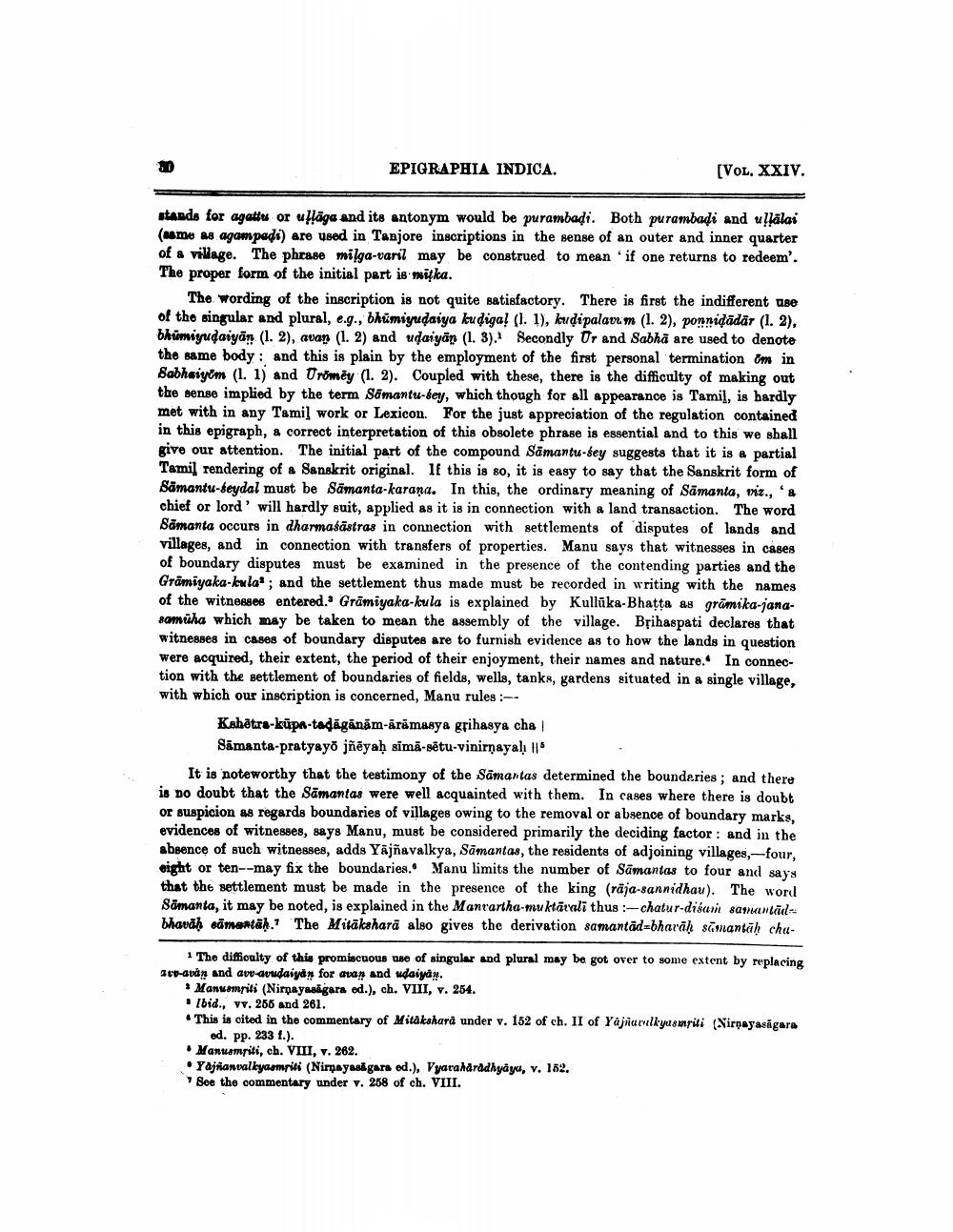________________
EPIGRAPHIA INDICA.
[VOL. XXIV.
stands for agattu or ullaga and its antonym would be purambadi. Both purambadi and uļļālai (same as agampadi) are used in Tanjore inscriptions in the sense of an outer and inner quarter of a village. The phrase milga-varil may be construed to mean if one returns to redeem'. The proper form of the initial part is mitka.
The wording of the inscription is not quite satisfactory. There is first the indifferent use of the singular and plural, e.g., bhümiyudaiya kuḍiga! (1. 1), kudipalavum (1. 2), ponniḍādār (1. 2), bhumiyudaiyan (1. 2), avan (1. 2) and udaiyan (1. 3). Secondly Ur and Sabha are used to denote the same body and this is plain by the employment of the first personal termination &m in Sabhaiyim (1. 1) and Uromey (1. 2). Coupled with these, there is the difficulty of making out the sense implied by the term Samantu-sey, which though for all appearance is Tamil, is hardly met with in any Tamil work or Lexicon. For the just appreciation of the regulation contained in this epigraph, a correct interpretation of this obsolete phrase is essential and to this we shall give our attention. The initial part of the compound Samantu-sey suggests that it is a partial Tamil rendering of a Sanskrit original. If this is so, it is easy to say that the Sanskrit form of Samantu-beydal must be Samanta-karana. In this, the ordinary meaning of Samanta, viz., a chief or lord' will hardly suit, applied as it is in connection with a land transaction. The word Samanta occurs in dharmasastras in connection with settlements of disputes of lands and villages, and in connection with transfers of properties. Manu says that witnesses in cases of boundary disputes must be examined in the presence of the contending parties and the Gramiyaka-kula; and the settlement thus made must be recorded in writing with the names of the witnesses entered. Gramiyaka-kula is explained by Kulluka-Bhaṭṭa as gramika-janasamuha which may be taken to mean the assembly of the village. Brihaspati declares that witnesses in cases of boundary disputes are to furnish evidence as to how the lands in question were acquired, their extent, the period of their enjoyment, their names and nature. In connection with the settlement of boundaries of fields, wells, tanks, gardens situated in a single village, with which our inscription is concerned, Manu rules :--
Kshetra-kupa-tadāgānām-aramasya grihasya cha | Samanta-pratyayō jñēyaḥ sīmā-sētu-vinirṇayalı ||
It is noteworthy that the testimony of the Samantas determined the boundaries; and there is no doubt that the Samantas were well acquainted with them. In cases where there is doubt or suspicion as regards boundaries of villages owing to the removal or absence of boundary marks, evidences of witnesses, says Manu, must be considered primarily the deciding factor: and in the absence of such witnesses, adds Yajnavalkya, Samantas, the residents of adjoining villages,-four, eight or ten--may fix the boundaries. Manu limits the number of Samantas to four and says that the settlement must be made in the presence of the king (raja-sannidhau). The word Samanta, it may be noted, is explained in the Manvartha-muktavali thus:-chatur-disum samantad bhavaḥ samantaḥ. The Mitakshara also gives the derivation samantad-bhavaḥ samantāḥ chu
1 The difficulty of this promiscuous use of singular and plural may be got over to some extent by replacing av-avan and avv-avudaiyan for avan and udaiyan.
Manusmriti (Nirnayasagara ed.), ch. VIII, v. 254.
Ibid., vv. 255 and 261.
This is cited in the commentary of Mitakshara under v. 152 of ch. II of Yajnavalkyasmriti (Nirnayasagara ed. pp. 233 f.).
Manusmriti, ch. VIII, v. 262.
Yajñanvalkyasmriti (Nirnayasagara ed.), Vyaraharadhyaya, v. 152.
See the commentary under v. 258 of ch. VIII.




